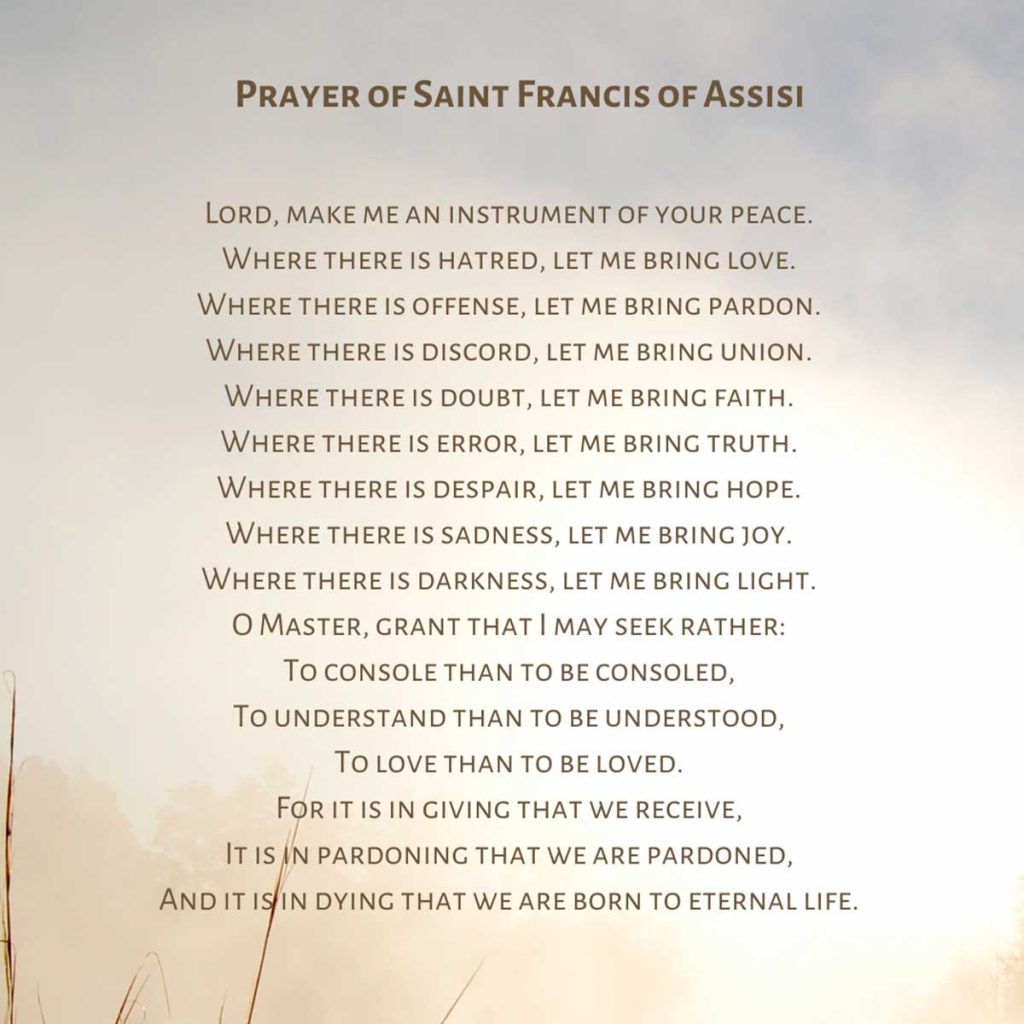The Prayer of Saint Francis of Assisi is one of the most well-known and beloved spiritual texts worldwide. With simple yet profound words, it has become a symbol of peace, brotherhood, and surrender. Many people turn to this prayer seeking comfort, strength to forgive, and inspiration to live with more love and compassion.
In this article we will explore in depth the meaning of the Prayer of Saint Francis of Assisi, its origin, its transformative message, and how it can be applied in everyday life. Throughout the text you will also find practical reflections, curiosities, and answers to the most common questions about this important spiritual legacy.
Prayer of Saint Francis of Assisi
The most familiar version of the Prayer of Saint Francis of Assisi is as follows:
Lord, make me an instrument of your peace.
Where there is hatred, let me bring love.
Where there is offense, let me bring pardon.
Where there is discord, let me bring union.
Where there is doubt, let me bring faith.
Where there is error, let me bring truth.
Where there is despair, let me bring hope.
Where there is sadness, let me bring joy.
Where there is darkness, let me bring light.
O Master, grant that I may seek rather:
To console than to be consoled,
To understand than to be understood,
To love than to be loved.
For it is in giving that we receive,
It is in pardoning that we are pardoned,
And it is in dying that we are born to eternal life.
This prayer touches the heart of those who seek a higher purpose and long to live more altruistically.

The History of the Prayer of Saint Francis of Assisi
Although the Prayer of Saint Francis of Assisi is traditionally attributed to the saint, it was not written by him. Its first recorded appearance was in 1912 in a French bulletin called La Clochette, published by a small religious order. Despite this, the values and teachings of the prayer genuinely reflect the spirit of Saint Francis of Assisi.
He lived from 1181 to 1226 in Italy and is remembered as the patron of ecology, peace, and the poor. His life was marked by simplicity, detachment, and love for nature and the most needy.
The Core Values of the Prayer
Peace and Reconciliation
The Prayer of Saint Francis of Assisi opens with the desire to be an instrument of peace. This is the pillar of the entire prayer and represents the longing for a more harmonious and brotherly world.
Love Instead of Hatred
By asking to bring love where there is hatred, the prayer calls for inner transformation. Loving others—even in the face of difficulties—is a daily and courageous choice.
Forgiveness and Understanding
The pursuit of forgiveness and understanding shows that the path of reconciliation rises above pride. This is one of the deepest messages of the Prayer of Saint Francis of Assisi.
Faith and Hope
Bringing faith where there is doubt and hope where despair reigns is an act of spiritual generosity. Each person can be a beacon of light in someone’s life.

Practical Applications in Daily Life
Personal Relationships
In moments of family conflict or with friends, mentally repeating the Prayer of Saint Francis of Assisi can help calm the mind and inspire more compassionate actions.
Work Environment
When dealing with professional disagreements, the prayer encourages understanding, respect, and the building of bridges rather than barriers.
Daily Reflection
Many people include the Prayer of Saint Francis of Assisi in their routine as a form of meditation, asking for strength to act with greater empathy throughout the day.
Why Is the Prayer So Powerful?
Simple and Accessible Language
The Prayer of Saint Francis of Assisi uses direct language without difficult words or strictly theological terms. This allows anyone, regardless of education level or religious background, to understand its content and connect with it emotionally.
Universality of the Message
Although often associated with Catholicism, its message is universal. It speaks of love, peace, forgiveness, and humility—values shared by many religions and by those who follow no specific belief. This makes the prayer a true bridge of union between different cultures and mindsets.
Invitation to Inner Transformation
Rather than merely requesting blessings, the Prayer of Saint Francis of Assisi proposes a change of attitude. It invites the one who recites it to become an agent of good—someone who brings light where there is darkness, love where there is hatred, and forgiveness where there is offense. It is a prayer that stimulates concrete action starting with personal transformation.
Inspiration for Everyday Life
Every line of the prayer can be applied to daily situations. In moments of conflict, insecurity, sadness, or anger, its words serve as a guide to respond with balance, compassion, and wisdom. This gives the prayer practical power that extends beyond the moment of prayer into real attitudes.
Strengthening Empathy
The Prayer of Saint Francis of Assisi fosters empathy by reminding us of the importance of loving, understanding, and consoling before wanting to be loved, understood, or consoled. This shift in focus—from “me” to “the other”—has a powerful effect on how we relate to the world.
Ability to Generate Inner Peace
Praying this prayer with attention and intention can calm the heart, relieve tension, and bring serenity. By focusing on acts of kindness and service, we shift attention from internal worries to a higher purpose, promoting emotional and spiritual balance.
Transforming the Surrounding Environment
By inspiring inner change, the prayer also positively influences the environment. When someone becomes more patient, compassionate, and generous, this behavior reflects in relationships and can motivate others to act with greater love. In this way, the prayer quietly transforms the world around us.
An Exercise in Humility
The prayer teaches us to seek less recognition and focus more on service. By declaring “to console rather than be consoled, to understand rather than be understood, to love rather than be loved,” it breaks selfish logic and proposes humility as the path. This is deeply liberating and makes us more open to grow and serve.
Spiritual Strength Without Imposition
One of the greatest powers of the Prayer of Saint Francis of Assisi is that it does not impose. It requires no ritual, dictates no religion, and places no conditions on God’s love. It simply offers a path: to be an instrument of peace. And that, in itself, brings transformation.

Curiosities About the Prayer
It Is Used by Different Religions
Although associated with Catholicism, the Prayer of Saint Francis of Assisi is recited in services of various Christian denominations and even in inter-religious gatherings.
It Has Been Cited by World Leaders
Figures such as Mother Teresa of Calcutta, John Paul II, and even political leaders in times of crisis have mentioned the Prayer of Saint Francis of Assisi as a symbol of unity.
Inspiration for Music and the Arts
The prayer has inspired song lyrics, paintings, and even literary works. Its message transcends time and remains current more than a century after its publication.
How to Teach the Prayer to Children
Accessible Language
Teaching the Prayer of Saint Francis of Assisi with simple explanations can help children understand the value of peace and empathy.
Creative Activities
Drawings, songs, and dramatizations are fun ways to incorporate the prayer’s message into a child’s world.
Spiritual Reflections Based on the Prayer
Being an Instrument of Change
By reciting the Prayer of Saint Francis of Assisi, an individual commits to being an agent of transformation, starting with oneself.
The Path of Humility
The prayer teaches that it is more important to love than to be loved, revealing humility as an essential virtue.
How to Memorize the Prayer of Saint Francis of Assisi
Reading the prayer aloud daily aids assimilation.
Dividing the text into smaller parts makes memorization easier.
Reflecting on the meaning of each verse strengthens internalization.
FAQ About the Prayer of Saint Francis of Assisi
Who was Saint Francis of Assisi?
He was a 13th-century Italian religious figure known for his love of nature, simplicity, and dedication to the poor.
Did he write the prayer?
No. The authorship is anonymous, but the prayer’s message reflects Franciscan teachings.
Can I pray it every day?
Yes. It can be included in daily devotions as a guide to a more compassionate life.
Is there a sung version?
Yes. There are many musical settings of the Prayer of Saint Francis of Assisi, popular in masses and celebrations.
Does it help in difficult times?
Many people report that the prayer brings calm, clarity, and inner strength during challenging moments.
Final Considerations
The Prayer of Saint Francis of Assisi is much more than a simple prayer. It is a profound invitation to live with more love, forgiveness, humility, and light. In a world marked by divisions and daily pressures, its words echo as a spiritual compass pointing to a path of inner peace and service to others.
Whether you are religious or not, it is worth reflecting on the message of this powerful text. May we, every day, become true instruments of peace, as Saint Francis of Assisi desired.
READ ALSO:
- Psalm 150: Final Praise and Celebration of God’s Greatness
- Psalm 149: An Invitation to Praise and Divine Celebration
- Psalm 148: Praise to the God Who Reigns Over All Creation
- Psalm 147: A Song of Praise to the God Who Restores
FOLLOW US ON FACEBOOK